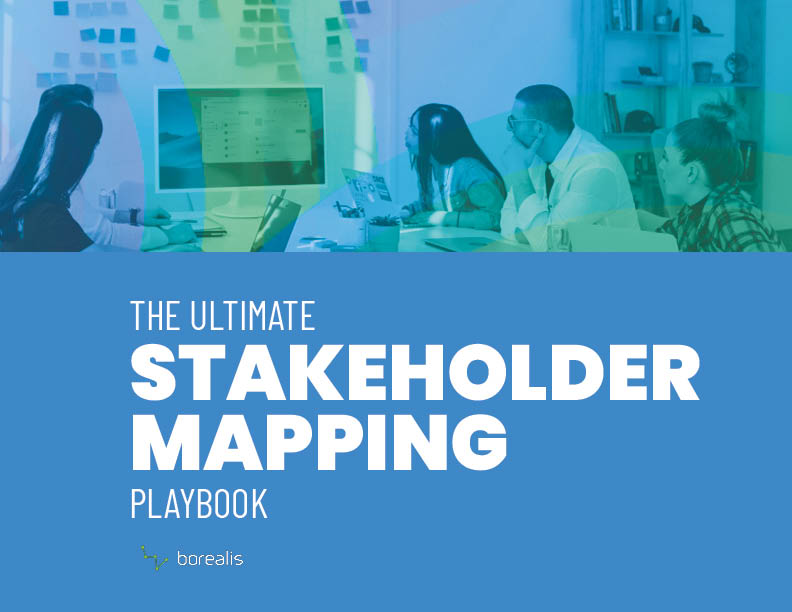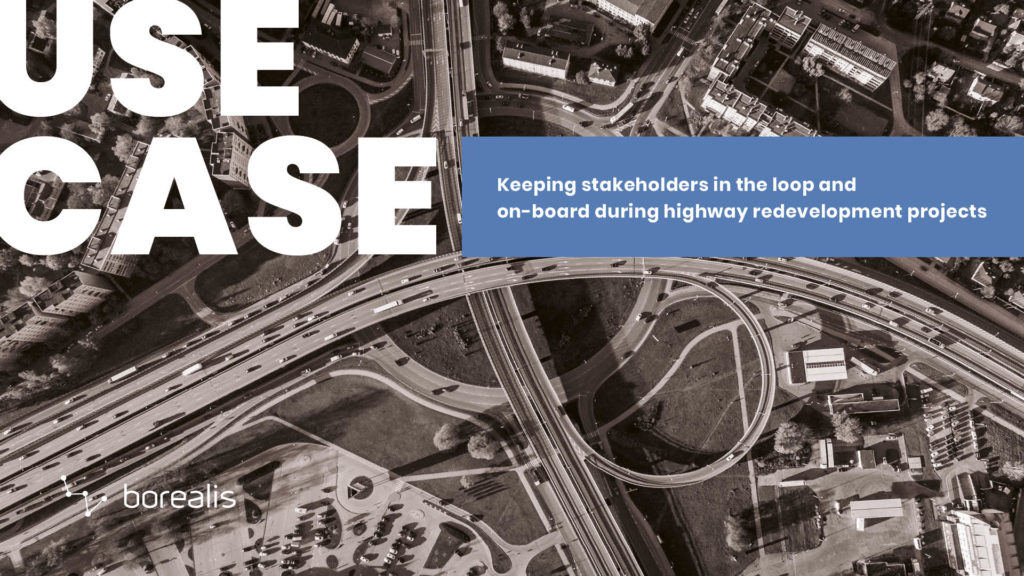Stakeholder management is crucial for organizations to secure project permits, manage complaints and grievances, earn stakeholder buy-in, and monitor legislative developments that could affect the organization’s financial performance. This guide provides best practices on how to create an effective stakeholder management strategy.
Jump to section:
- What is stakeholder management?
- Why is stakeholder management important?
- What is an effective stakeholder engagement strategy?
- Benefits of an effective stakeholder management strategy
- Steps in creating an effective stakeholder management strategy
- Meaningful stakeholder engagement
- Measuring stakeholder management
- Common challenges in stakeholder management
- Example of an effective stakeholder management strategy
What is stakeholder management?
Stakeholder management ensures that the needs and interests of individuals or groups with a stake in a project, organization, or decision are considered during decision-making. Organizations invest in stakeholder management to manage and mitigate any potential negative impacts that may arise.
The stakeholder management process typically begins by identifying:
- Who your internal and external stakeholders are
- What their interests and needs are, along with their level of influence over your project
- What are the best ways to manage these interests, needs, and influences effectively
Why is stakeholder management important?
Effectively managing stakeholders can be a powerful way to:
- Identify project risks and opportunities to improve decision-making.
- Manage stakeholder risk to secure social acceptance.
- Better address stakeholder needs to build more positive relationships.
- Achieve more positive social impacts and better project outcomes.
- Improve trust among key stakeholders, smoothing the way for future projects.
Another reason why stakeholder management is important?
It is often a requirement of key external stakeholders. Many regulatory agencies and government bodies require companies to demonstrate that they have engaged with stakeholders and addressed their concerns as part of the permit application process.
Stakeholder management professionals therefore need to master the stakeholder management process and create an effective stakeholder management strategy for achieving these benefits.
Learn everything about stakeholder management
in our ultimate guide
What is an effective stakeholder management strategy?
A stakeholder management strategy is a plan to identify, engage, and monitor internal and external stakeholders.
A good strategy for managing stakeholders should identify:
- All key stakeholders and their interests, concerns, and level of influence
- Any potential risks or opportunities related to their involvement in the organization’s activities
- The approach chosen to engage these stakeholder groups effectively:
- The communication channels and methods that will be used
- The tools and resources that will be required
An effective stakeholder management strategy aims to build positive relationships with stakeholders, address their concerns and needs, and ensure that their perspectives are taken into account in decision-making processes.
Implementing a stakeholder management strategy is often necessary for reporting to legislators or project sponsors. It may also be subject to a standard requirement, such as the Towards Sustainable Mining (TSM) standard.
Benefits of an effective stakeholder management strategy
Having a solid strategy to ensure effective stakeholder management can benefit your organization in many ways.
Improved stakeholder relationships
Engaging with stakeholders and understanding their needs and concerns can lead to increased stakeholder trust, loyalty, and support.
Reduced risk
Better reputation
Increased innovation
Better decision-making
Best Practice: Follow effective stakeholder engagement techniques to maximize the potential benefits of your stakeholder management strategy.
- Dedicate adequate resources to identifying and addressing stakeholder concerns (stakeholder mapping).
- Engage stakeholders early and often to proactively build strong relationships.
- Use a variety of communication channels to engage with stakeholders.
- Involve stakeholders in decision-making processes.
- Be transparent and accountable in all stakeholder interactions.
- Have a clear plan for managing grievances and resolving disputes, and put the necessary grievance and feedback mechanisms in place.
Give stakeholders an easy self-serve online platform for filing grievances and sharing feedback on your project with Borealis software's grievance and feedback portal.
Steps in creating an effective stakeholder management strategy
Creating a stakeholder management strategy involves several key steps:
Identify stakeholders
Create a comprehensive list of internal and external stakeholders who may be interested in, affected by, or hold influence over your project or activities.
Internal and external stakeholders may include employees, customers, suppliers, regulators, shareholders, community members, and government officials, as well as industry, environmental and indigenous groups.
Analyze stakeholders
Analyze stakeholders: Determine the needs, concerns, and expectations of each stakeholder group, and prioritize them based on their level of importance.
Best Practice: Devote enough resources to thoroughly map stakeholders. Update your map regularly as stakeholders come and go, roles change, and the project advances.

Develop a communication plan
Determine the most effective communication channels to reach each stakeholder group. This may include meetings, emails, texts, newsletters, social media, or other forms of communication. Determine the timing, frequency, and content of communications.
Engage stakeholders
Actively involve stakeholders in your project or activities, and seek their feedback and input throughout the process. Focus on meaningful engagement.
Record stakeholder engagement activities
Record stakeholder engagement activities. Keep complete and up-to-date records of all stakeholder engagement efforts, regardless of communication method, to maintain a clear overview.
Best Practice: Use stakeholder engagement software to centralize all stakeholder data and engagement activities so that this information is easily available to team members at all times from any device or location.
Monitor and evaluate your strategy
Meaningful stakeholder engagement
Meaningful stakeholder engagement entails actively involving stakeholders in decision-making processes, valuing their input, interests, and concerns, and building genuine relationships with stakeholders based on mutual trust and respect.
When stakeholders feel heard and valued, they are more likely to support the project or business activity and work collaboratively towards successful outcomes.
Some organizations need to change their mindset to engage stakeholders in a genuinely meaningful way:
- See stakeholders as partners and involve them in all stages of the project.
- Use communication channels that reflect their preferences.
- Maintain open and honest two-way communication, consultation, and collaboration.
- Engage stakeholders early in the project and continue to engage as needed based on priority level.
Best practice: Follow industry guidelines, such as the OECD Due Diligence Guidance for Meaningful Stakeholder Engagement in the Extractive Sector.
3 concrete ways to achieve meaningful stakeholder engagement
1. Communicate effectively
Use multiple communication channels to communicate effectively with stakeholders, and base your choice on the preferred method of communication determined during the stakeholder analysis phase.
Exemple of typical communication channels for stakeholder engagement are:
- Face-to-face meetings and consultations with stakeholders
- Email, phone, and direct mail communication
- Social media platforms, such as Twitter, Facebook, and LinkedIn
- Surveys and feedback forms
- Stakeholder management software that allows for centralized communication and feedback collection
2. Effective stakeholder grievance and feedback mechanisms.
Grievance management mechanisms are crucial to meaningful stakeholder engagement. The value of providing stakeholders with an easy means to voice grievances and share feedback on projects cannot be understated.
Organizations that practice honest, open two-way communication:
- Are better able to identify and address emerging issues before they escalate into more significant problems.
- Build trust and credibility with stakeholders by showing them that their input is valued and that their concerns are taken seriously.
- Demonstrate a commitment to transparency and accountability, which can lead to improved stakeholder relationships and increased support for projects or business activities.
- Are better able to identify areas for improvement and make necessary changes to improve project outcomes and social impact.
- Strengthen the credibility and reliability of reporting to financial stakeholders.
Best practice: Give stakeholders access to an online self-service grievance and feedback portal that makes it easy for them to share feedback and raise grievances, whether anonymously or not.
Monitor your stakeholder management
Measuring the success of your stakeholder management activities can contribute to more meaningful engagement with stakeholders. Track progress against key performance indicators, such as stakeholder satisfaction, engagement levels, and project outcomes. Taking those steps is crucial to make sure that the engagement plan paid off and that any identified gaps are identified and addressed.
Use both quantitative and qualitative methods:
- Use surveys, feedback forms, and other data collection tools for quantitative data on stakeholder opinions and behaviors.
- Use interviews, focus groups, and other qualitative methods for insights into stakeholder perspectives and experiences.
Best Practice: Regularly measure the effectiveness of your stakeholder management strategy. Assess any gaps, evaluate risks, and make adjustments as needed to ensure that you are meeting the needs and expectations of your stakeholders.
Common challenges in stakeholder management: How to overcome them
Stakeholder management can be challenging for organizations, particularly those with a low level of data management maturity. The following are some of the common challenges in stakeholder management that you may face:
- Keeping an up-to-date view of the shifting stakeholder landscape over time
- Managing conflicting stakeholder interests and addressing concerns effectively and promptly
- Managing engagement activities with a large number of stakeholders or staff
- Creating a structured corporate memory when using different communication tools
- Locating stakeholders in land-based projects due to a lack of visualization tools
- Reporting on corporate and social responsibility in an effective and timely matter due to a lack of stakeholder engagement measurement and reporting tools
- Complying with stakeholder regulations and requirements
Best Practice: Improve your data management maturity. By using fit-for-purpose stakeholder relationship management software, you can centralize all stakeholder data, break down information silos, and keep data at your fingertips for easy access. This approach can help you address challenges and improve your stakeholder management practices.
Example of an effective stakeholder management strategy
Here’s a real-world example of how to create and implement an effective stakeholder management strategy according to the best practice of using stakeholder management software.
In this example, we’ll review a stakeholder management strategy that was created to identify and manage the interests, expectations, and concerns of stakeholders involved in the recent construction of a light rail system in the U.S.
Step 1: Identifying stakeholders
The following stakeholders were identified as having a vested interest in the light rail construction project:
Local government agencies
City and county officials, transportation departments, and other government entities responsible for overseeing the project and ensuring compliance with local regulations.
These stakeholders were easily identified by cross-referencing the GIS information imported in the Borealis Land Management tool which outlines the municipalities the rail system will cross, and then looking in the Elected Officials Database in Borealis to see who the local elected officials were.
Community members
Residents in the areas where the light rail system was being constructed and potential rail users.
These stakeholders were identified by publishing invitations for public consultation, posting announcements on social media, sending letters to all residences in a specific zip code, etc. All respondents were added to the centralized stakeholder management system to retain a historic memory of interactions.
Landowners
Individuals and entities owning land or residing on properties next to the rail line or who needed to be displaced, or whose land the team will need to access during the construction phase and/or afterward for ongoing maintenance, etc.
They were identified by consulting the land registry. This information was added in bulk to the stakeholder management software through shapefiles and Excel spreadsheets.
Business owners
Local business owners whose operations may be impacted (positively or negatively) by the construction or operation of the light rail system.
Rather than the traditional door-to-door approach, these stakeholders were identified by using Google Maps in the mapping function of Borealis software to save time.
Other interested or impacted parties
Environmental groups, advocacy groups, and other organizations with an interest in the project. The light rail proposed path crosses an environmental justice area, so community members of this area benefitted from a different approach in terms of engagement.
These stakeholders were identified by reviewing the historical data of previous projects.
Step 2: Mapping and analyzing stakeholders
A stakeholder analysis was conducted to better understand the interests, expectations, and concerns of the various stakeholders and this was the result of the analysis
Local government agencies were concerned with ensuring that the project complies with local regulations and that the construction process did not disrupt the surrounding community. They were also concerned with the long-term sustainability and viability of the light rail system.
Community members were interested in the benefits that the light rail system would bring, such as improved access to transportation, reduced traffic congestion, and reduced carbon emissions. They were also concerned with the potential disruption to their daily lives during the construction phase.
Business owners were concerned with the potential impact that the light rail system might have on their operations. They were interested in ensuring that their businesses could continue to operate and that they were not negatively impacted by the construction or operation of the light rail system.
Environmental justice area. Members of this at risk community are concerned by the delocalization that might take place. It was also identified that the fair and thorough consultation of the community might be a challenge considering that most members of this EJ community don’t speak English fluently. Also the high average age of the population might indicate that members could refuse or have difficulty to access traditional digital channels of communication such as social media, emails and online platforms.
Step 3: Engaging stakeholders
The following engagement strategies were used to mobilize and manage the various stakeholder groups throughout the light rail construction project:
Local government agencies
Meetings were held with local government agencies to ensure the project complied with local regulations and that concerns were being addressed. Collaboration was encouraged to ensure the project met the needs of the community while also fulfilling the goals of the project.
Community members
Regular community meetings and information sessions were held to inform community members of project updates, milestones, and potential disruptions. Feedback was solicited to address concerns and ensure the needs of the community were being met.
Business owners
Meetings were held with local business owners to ensure their concerns were being addressed and to develop strategies to minimize the impact of the construction or operation of the light rail system on their operations.
Land owners
Since formal consent was needed from landowners to access their land during the project, formal letters were sent and phone follow-ups were scheduled. All land access conditions were documented in the parcel records. A different set of communications was sent to land occupants informing them of upcoming work. Both land owners and occupants were informed of how they could submit feedback, questions and complaints before, during, and after the construction process.
Environmental justice area
Staff that spoke the language most commonly spoken in this area were hired to host public consultations. They also invited influential stakeholders from the area to join a special subcommittee for regular meetings to discuss project benefits and address community concerns. These efforts were supported with printed material in the spoken language. A social investment fund was also set up.

Step 4: Measuring stakeholder engagement activities
The company used the dashboard in Borealis software to regularly measure and record the results of its stakeholder engagement efforts based on its set KPIs for each group. Key internal decision makers such as the Community Relations Manager and VP of Public Affairs received daily or weekly updates on activities, emphasizing the indicators most useful for them.
For example, for community members, the company tracked:
- The number of communications that took place over a given period.
- How stakeholder position and sentiment changed over time.
- How grievances and resolution times changed over time.
Best practices checklist for successful stakeholder management
Dedicate adequate resources to identifying stakeholder and addressing concerns
Engage stakeholders early and often
Involve stakeholders in decision-making processes
Stay proactive, transparent, and accountable in stakeholder interactions
Have a clear plan for managing grievances and resolving disputes
Continually measure the effectiveness of your stakeholder management strategies and adjust course as needed
Implement a fit-for-purpose stakeholder management software rather then risk failing at customizing a CRM.
These best practices will help your organization build stronger relationships with stakeholders, reduce project risks, improve its reputation, increase innovation, and make better decisions.
With an effective stakeholder management strategy in place, you will be better able to achieve your goals and succeed in the long term.





